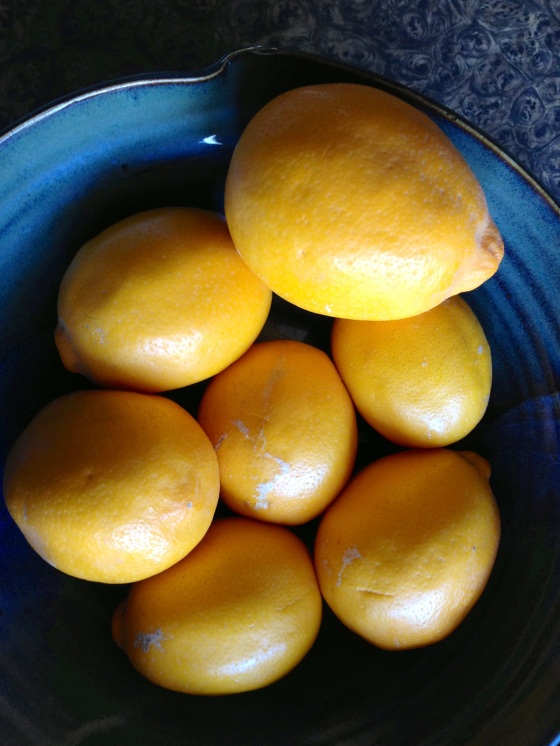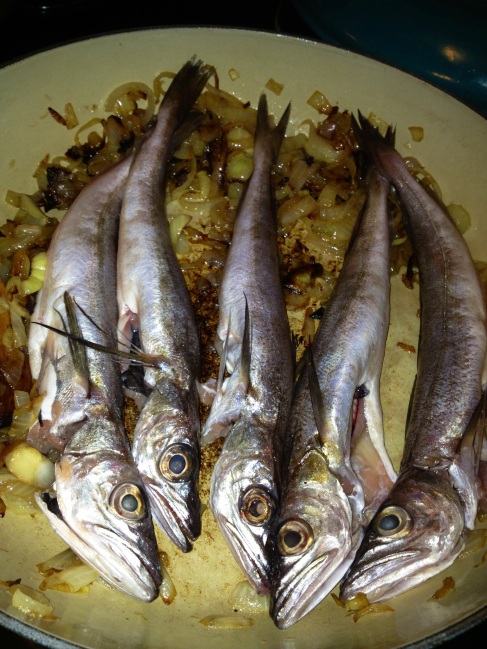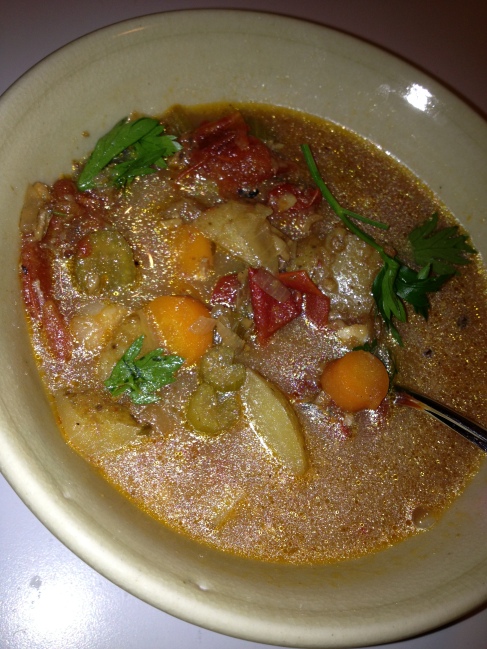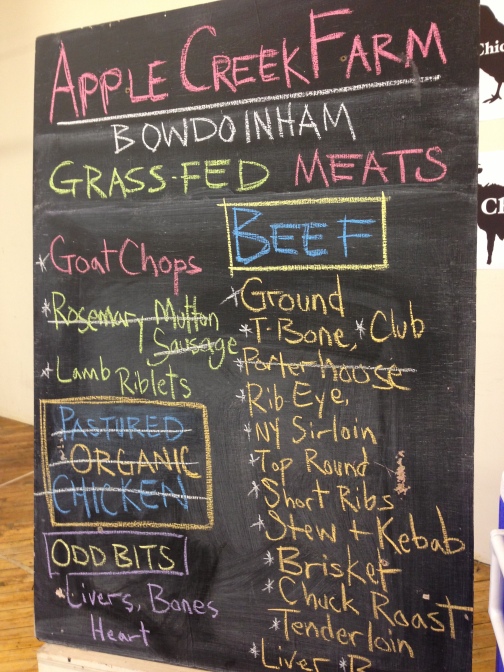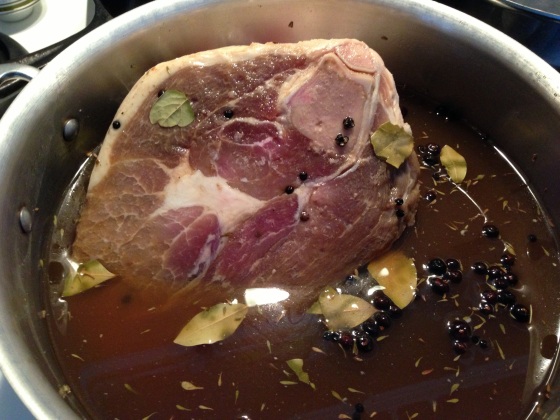Irish Moss Blanc Mange and Panna Cotta with Agar-Agar: Vegan Seaweed Says Move Over, Gelatin!
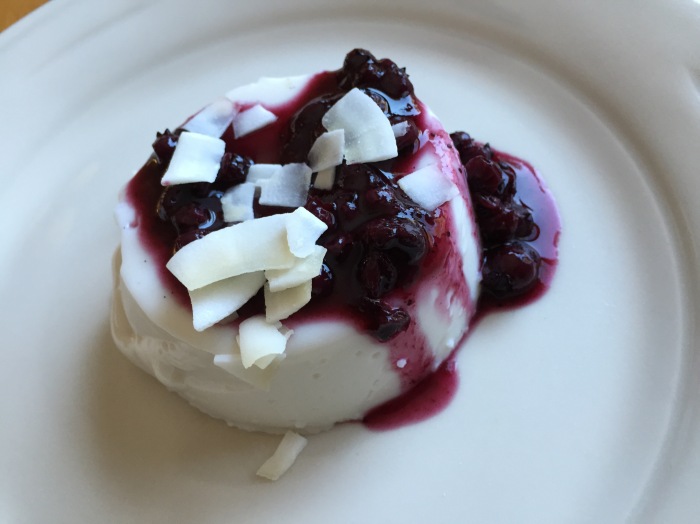
Coconut milk panna cotta, congealed with agar-agar instead of Knox gelatin. (From Heidi Swanson’s “Super Natural Cooking,” recipe ran with my Portland Press-Herald column here.)
As longtime readers of this blog will remember, luscious Italian panna cotta is one of my favorite desserts. I guess that reveals I’m not much of a baker, but I just love how unflavored gelatin coaxes this creamy dessert into an addictive, jiggly texture upon chilling. Still, years ago, when I posted my panna cotta recipe, a vegetarian friend had asked about a suitable non-animal substitute for gelatin that’s since haunted me. She wondered if pectin would work. I found a packet of seaweed-derived agar-agar at an Asian market about that time, but never used it. Its package indicated it would congeal juicy, sugary desserts just like gelatin.
Then I heard about a new (well actually very old-time) technique for congealing milk puddings at this revelatory, delicious seaweed cooking class I took through UMaine Extension in February. Several women in the class waxed nostalgic about how their Maine grandmothers gathered washed-up Irish moss seaweed on the coast to boil into the congealed dessert blancmange. Their enthusiasm inspired my latest The Farm-to-Table Family column for the Portland Press-Herald: “Who Needs Boxed Jell-O When Maine Seaweed Abounds?” (Heidi Swanson’s coconut milk panna cotta recipe is excerpted there.) In that article, I promised to give readers an Irish moss blanc-mange recipe on my blog. Here it is below the picture:
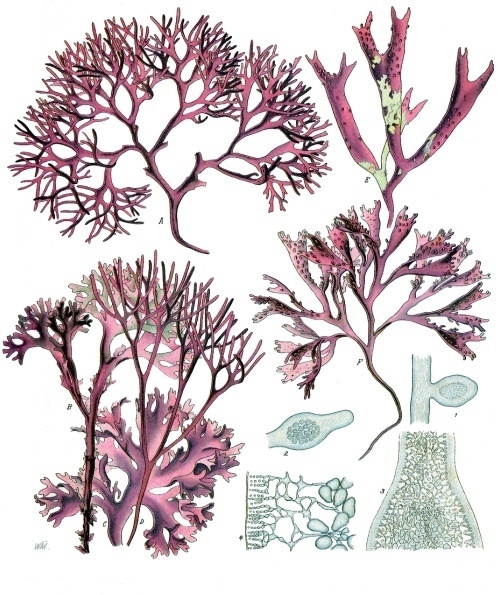
Red algae Irish moss seaweed is boiled with milk in lieu of animal gelatin to make the old-fashioned pudding, blanc mange. It thrives on the Maine coast and is the source of the ubiquitous food additive carrageenan, long extracted here at a plant in Rockland. (Image from Wikipedia)
Irish Moss Blanc-Mange Dessert Pudding
This recipe come from Prannie Rhatigan’s esteemed “Irish Seaweed Kitchen” cookbook. Maine seaweed harvester Kelly Roth of VitaminSea in Buxton told me, “It’s pretty much our bible,” with wide-ranging recipes for incorporating seaweed into quotidian cuisine, from mashed potatoes to pot roast. Rhatigan’s recipe comes from the “hallowed kitchens” of the Ballymaloe House in County Cork, Ireland. Hence the the metric system measurements. You can order dried Maine Irish moss from the websites of local harvesters Maine Coast Sea Vegetables out of Franklin, or VitaminSea from Buxton.
Serves 6
3.5 to 4.5 grams Irish (carrageen) moss, depending on variety (Kelly Roth recommends using the dried seaweed, soaked in fresh water to remove ocean salt)
1 1/2 pints (850ml) milk
1/2 teaspoon vanilla extract or vanilla bean pod
1 1/2 ounce (50g) sugar
1 egg, separated
1. Soak the carrageen (Irish moss) in cold water for 10 minutes, then remove and put in saucepan with milk and a vanilla pod, if using.
2. Bring to the boil and simmer very gently for 15 minutes, semi-covered, taking care that it does not boil over.
3. The carrageen (Irish moss) will now be swollen and exuding jelly.
4. Pour through a strainer into a mixing bowl.
5. Rub the jelly through a strainer and beat it into the milk with the sugar, egg yolk and vanilla essence, if using.
6. Whisky egg white stiffly and fold it gently into the mixture; it will rise to make a fluffy top. Transfer to serving bowl.
7. Serve chilled with a fruit compote (strawberry-rhubarb would be ideal when the season comes late this spring), or a sweet sauce. I served the above coconut milk panna cotta with my Maine wild blueberry-maple syrup preserves.

Found at health food stores and Asian markets, seaweed-derived agar-agar is a good vegan substitute for gelatin.
Heidi Swanson’s Coconut Milk Panna Cotta congeals with seaweed-dervived (from a red algae source similar to Irish moss) agar-agar that I found at my local natural foods store. Use this if you don’t have access to Irish moss. Japanese native, Hiroko Meserve, a mom here in Brunswick, told me she uses agar-agar (called kanten in Japanese) to gel fresh grapefruit juice desserts and also to make the popular Japanese red bean paste sweet, yokan. Agar-agar also gels the popular Chinese almond milk (technically made with apricot kernel, traditionally) pudding know as annin tofu. It masquerades as tofu, when cut into white cubes before serving.
We all know kids love the color and taste of Jell-O. It’s inspiring to discover they love seaweed just as much, and desserts congealed with agar-agar instead of gelatin. I found this out when I went into my son’s preschool last week to read this “Aquaculture for ME” book put out by the Maine Agriculture in the Classroom program. Theo is now obsessed with this book and requests it most nights at bedtime. This program is funded by those Maine agriculture license plates we are proud to sport on our Subaru–get yours today!
I brought the preschoolers a snack of blueberry-kelp smoothies (made with dried Maine kelp I soaked and rinsed of salt) and 100 percent fruit juice vegan Jell-O, thickened with only agar-agar (follow the easy instructions on the package). They particularly gobbled the later up.
Life Gives You Meyer Lemons? Make Limoncello.
Meyer lemons in the store are often tinged with a mildewy flavor. The problem is the rare lemon-orange hybrid citrus ripens quickly and, since it isn’t so self-stable, doesn’t travel easily. They’re a formerly disease-prone hybrid that actually originated in China. So most of the Meyer lemons I’ve had have been a disappointment. Until now.
I was surprised this week with eight perfectly ripe Meyer lemons from a new colleague of Dan’s who hails from Salida, California, and studied at UC-Santa Cruz. They were a gift in exchange for our offer to dog-sit his sweet Julia, a brindled former Mexican street dog Marcos adopted while doing field work there about five years ago. While Theo loved our friend‘s pit-bull Baba, he appears to have developed a new-found fear of canines that I’m hoping to nip in the bud, through aversion therapy:) The gift of the Meyer lemons this week only sweetened the deal.
Marcos relayed that the Meyer lemons come from the backyard of the house where he grew up. His dad passed away last September and since his mom no longer lives there, the tree was loaded with almost overripe fruit. The tree was one of his dad’s prized possessions, in addition to his key lime tree. This detail made me all the more honored to have this fruit, which I approached with reverence. It was tangy-sweet just squeezed into the mouth and into seltzer water.
But a quick search of the web made me realize that when life gives you ripe Meyer lemons, one should turn to limoncello before they go south. I’ve never made limoncello before but have long wanted to. Dan feel in love with it and other fruit liqueurs traveling with his cousin in Italy that summer 2003 just weeks before we met. Most limoncellos only call for the rind but I had golden orbs bursting with juice. I did squeeze a little into my now-famous scallop ceviche. The rest are quartered and bathing in vodka for Meyer Lemon Limoncello, as instructed by the excellent Oregon food blog Voodoo & Sauce (I once interviewed blogger Heather about foraging for stinging netttles). Zester Daily seconded her approach. Next time, I’ll try Meyer lemon mayonnaise.
Whole Fish Stock (with Whiting a.k.a Silver Hake a.k.a Lake Trout, Heads and All!)
It’s my second September living year-round in Maine, and the access to fresh, affordable seafood is one of the things I’m most grateful for after more than a year here. Of course the produce is incredibly bountiful now, though a chill is setting in. I can barely keep up with our C.S.A. and my neglected community garden plot’s bounty. I’m actually a member of three C.S.A.s at the moment–incredibly indulgent I know, though I believe they are saving us money on food costs if you pencil everything out. In addition to the vegetable C.S.A., I just started John Bunker’s incredible bi-weekly “Out on a Limb” heritage apple C.S.A. program. And on and off for almost a year now I’ve had the privilege of being one of the inaugural members of the Salt & Sea Community-Supported Fishery, which does a weekly drop of fresh-from-the-boat fish and shellfish in Brunswick. I’ve had a chance to cook with some of the freshest fillets of pollock, Acadian redfish (my new favorite…especially pan-fried for fish tacos), haddock, dabs and monkfish you can imagine. Every week, owner Justine Simon emails us a suggested recipe for that week’s fish, which can usually be assembled with ingredients you have on hand. It takes all the guesswork out of coming up with dinner and then procuring those items. Effortless, delicious fish dinner!
Unfortunately, Justine says last week’s share caught many members off-guard. I was delighted to get her announcement of whole fish for the first time: “some lovely little whiting (silver hake) tonight from Jerry and crew on the Teresa Mare IV. They caught them close to shore as they were coming in from their trip,” Justine wrote. It’s also GMRI’s fish of the month in their excellent Out of the Blue Campaign.
I’ve had a fascination with whiting ever since living in Baltimore, where filets of the cheap fish are fried and known as the local delicacy, Lake Trout (not from a lake nor a trout). As Justine went on, “Whiting is considered a delicacy in many different types of cuisine, and is more often than not prepared whole.” I’m not sure if you can call young whiting “scrod,” but seems to be similar to young cod, haddock and other whitefish.
The whole fish thankfully came gutted and cleaned. Justine said folks most often remove the head, fins and tail, then dredge the fish in egg and flour and either fry or bake them. But my in-laws had just arrived, so we opted for take-out (something we rarely do) to avoid the mess of frying fish.
So I gladly opted for Justine’s latter suggestion that whiting are perfect for fish stock for those who “don’t want to wrestle with small fish.” I’d never made fish stock before, but this was the perfect alternative, since we weren’t eating the fish right away. Plus, I’ve always been disappointed by the canned version. Doesn’t seem worth paying for doctored water when you have time to make your own. Justine goes on: “I was talking to an Italian woman while the boats were unloading and she gave me a simple recipe that we made last night, and it was delicious:
Fry some onion and garlic in olive oil, cook on low heat until onions are caramelized. Add plenty of water, some salt and the fish. Bring to a boil and let simmer for an hour or so. Strain, so all you are left with is clear stock. Put back in pot, and add more water, finely diced potato and carrot, orzo, parsley, salt and pepper. Yum!”
We simmered potatoes, carrots, celery, fennel, onions and tomatoes from our CSA and/or my garden in the stock, which made for a delicious meal. I just used a mesh ladle strainer to remove the fish bodies, picking off the sweet delicate meat that gave right away from the bone. It would also be perfect for bouillabaisse, cioppino or my grandmother’s Manhattan-style clam chowder.

Bagels from Union Bagel in Portland. Pale perhaps, but still chewy and delicious. At least far better than the insipid, roll-like, Mr. Bagel or Einstein’s alternative.
Surprisingly, Justine reported “overall the whiting didn’t get great reviews from the CSF.” How I often forget my tastes are more exotic and adventurous than my average fellow American. Fortunately, several members rallied to tell Salt & Sea they liked it! So they’ll at least offer it again as a preference that people of which people can opt out. Count me in! I’m ready to continue to get my hands dirty with fresh fish. If only I could have smoked these small fish as a stand-in for whole smoked whitefish at our lovely Yom Kippur break-fast we had with friends this year. I brought the bagels, local Maine lox and cream cheese instead.
Kidneys Aren’t So Offal After All
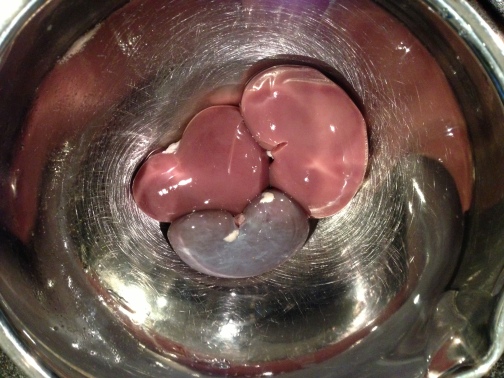
Goat and lamb kidneys (I think the smaller grey one is lamb) from Apple Creek Farm in Bowdoinham. Surprisingly delicious if first soaked in salt water and then alcohol, to remove much of that urine-y essence.
The taste-buds of toddlers, even the most omnivorous of ones, seem to grow pickier near the age of two. That’s certainly been the case with Theo. We depend upon green smoothies, fortified with kale and carrots, to get vegetables into him now. He tends to favor plain starches, bananas and peanut butter, granola and other sweet items these days. So we were delighted to discover he had a taste for lamb kidneys and liver, and tripe soup, at a recent special Greek diner menu at our beloved Trattoria Athena here in Brunswick. I was also happy to discover I had a taste for kidneys, after my unpleasant experience with rabbit ones a while back. And pleased to discover Apple Creek Farm in Bowdoinham sold delicate lamb and goat kidneys at my Brunswick farmers’ market for an affordable $3 a pound. Apple Creek farmers Jake and Abby said the only other customers who ask for them are mothers inspired by Sally Fallon’s Nourishing Traditions.
I’ve bought lamb and goat kidneys twice from them now and found them delicious. I think the goat ones had a more off-putting barnyard aroma, but by eating time, I got confused which was which. To remove the kidneys’ urine flavor (hey, urine is sterile anyway:)), I soaked them in heavily salted water and then some beer the first time and sweet vermouth the second time I made them. For a recipe, I adapted Mark Bittman’s one for breaded veal kidneys sauteed with shallots and sherry, from his How to Cook Everything. I drained the kidneys and discarded their liquid, removed tough white membranes, sliced them into tender medallions, salted and peppered them, then dredged in flour and pan-fried in butter. I kept them warm in a 200 degree oven while I sauteed shallots with more butter in the pan, and then deglazed it with sherry and sweet vermouth and a touch a maple syrup for sweetness. That sauce goes over the kidneys. Serve warm with crusty bread.
Unfortunately, now-finicky Theo refused the kidneys both times at home. Mama sure enjoyed them as an appetizer, but their richness, like liver but with a sweeter, less metallic flavor, meant I couldn’t make a meal of them. A little goes a long way with offal. Let’s hope this kid becomes omnivorous again when he turns two in June. What happened to my keen sardine eater?
Pork, Pork and More Pork (Plus Recipes)

Butcher case at Rosemont Market’s Brighton Avenue location, where local lard is touted as the new olive oil. Pork there is from Milkweed Farm right here in Brunswick.
I’m totally spent, after appearing on local TV for the first time, and banging out a cover story for The Portland Phoenix’s pig issue, plus my side column take on Jews and pork. I attended a whole hog butchery workshop (lung was delicious, spleen was gross) and have tracked down numerous chefs, pig farmers and butchers. I remain indebted to Oregon for teaching me how to cure my own guanciale and to seek out meat CSAs and heritage Red Wattle hogs. Now, for some recipes (previously discussed on our latest WBOR radio show on food waste).

Breaking down half a hog in the butchery and curing workshop organized by Giant’s Belly Farm in Greene, Resilient Roots and the Local Sprouts Cooperative.
First, pig ears, normally considered dog food/dog chew toy. Perhaps they should stay that way. I’m all for crispy pig ears at restaurants, but I found them a bit gross and not worth the effort to do at home. I worried about ear wax and hating shaving the ears of hair. For a recipe, I consulted the trusted Michael Ruhlman, a charcuterie guru with a new book out (with co-author chef Brian Polcyn, whom I interviewed) on the porky art of Italian dry-cured Salumi. He recommended prepping pig ears confit-style.
So I rubbed the ears with salt, pepper, garlic and Chinese five spice powder and let them cure overnight (well, ok, they were left in the fridge for a few nights). I was thinking crispy pig ear banh mi. That never happened. I confited them in a super-low oven in grapeseed oil (didn’t have lard). But when I tried to fry them up, they were chewy and gummy and not that crisp. I now see I ignored Ruhlman’s advice to roast them, weighed down between pieces of parchment in a 425 to 450˚ oven. My bad. I missed his note that “a serious issue with frying is that water remaining in the skin can cause them to pop and splatter in hot fat.” Splatter they did.
The pork roast, really an uncured bone-in ham, recipe I tried from Tamar Adler‘s An Everlasting Meal: Cooking with Economy and Grace proved far more satisfying. I got to taste a little roasted bone marrow, which tasted just like that fancy restaurant appetizer. The next day, I made a good ole New England pot of baked beans, flavored with the bone and pork scraps, inspired by a recipe in a recipe from the revamped classic Cooking Down East. Here’s Adler’s recipe…you definitely want to try to brine the ham first, to tenderize the dense muscle. I added molasses and liquid smoke to the brine, to make the meat, well, more ham-like.

The lovely bone-in ham roast (see that yummy bit of marrow) from a Red Wattle hog from Squire Tarbox Farm on Westport Island.
Meat brine (from Tamar Adler’s An Everlasting Meal; roast follows)
1/4 cup salt
1/2 tablespoon sugar (I used molasses too)
water
2 bay leaves
2 whole dried chiles
1 teaspoon juniper berries
4 sprigs thyme
1 teaspoon peppercorns
Combine the salt and sugar over low heat with 1/4 cup water. As soon as the salt and sugar have dissolved, take it off the heat. In the container in which you’re going to brine the pork leg roast, combine everything with a few ice cubes. Mix it all well. Once it is cool, add the meat and water to cover. Brine, before meat is added, stays good forever.
Pork roast
Brine a three-pound pork leg roast (preferably bone-in for flavor) overnight in the refrigerator. Cover the meat with a plate that fits inside the container and weigh it down so that it doesn’t float. Heat the oven to 375 degrees. Remove the pork from the brine and pat it dry. Heat a cast-iron pan or heavy-bottomed pot over medium heat and add 1 tablespoon olive oil. Brown each side of the meat over medium-high heat. Let each side turn caramel brown. This will take 10 to 15 minutes.
Once the pork is browned, put the pan or pot directly in the oven. Cook the meat, untouched, until it’s medium-rare. In an oven, this will take about 20 minutes per pound. Pork will need an internal temperature of 165 degrees when you pull it out of the oven, and will go on cooking once you remove it. Err on the side of under-cooking the meat. Check it with a meat thermometer at its thickest part until you get good at telling doneness by pressing on the meat.
Remove the meat from the pan and let it sit on a cutting board. It needs to rest for at least 20 minutes. Sliced earlier, the outside of the pork may taste salty; if there is still a bone in the cut, the meat along it will still be bloody.
Slice the meat thinly with a sharp knife. If you can avoid it, leave the serrated knife for bread and use the sharpest straight blade you have.
Serve with a big green salad.
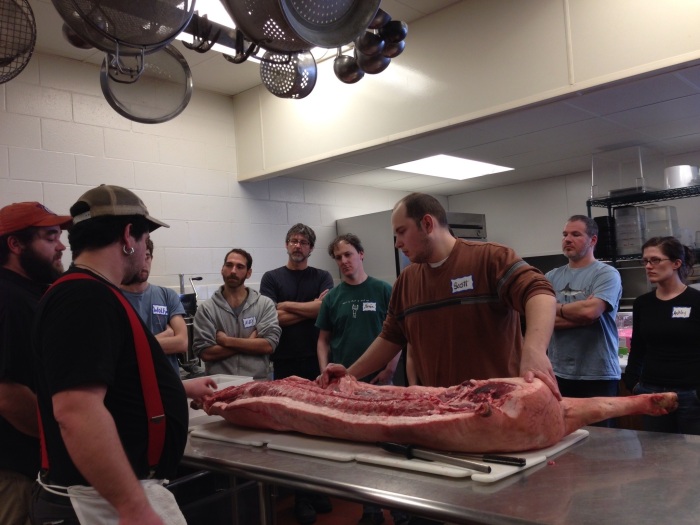
Hog butchery workshop in South Portland (notice James Beard Award winning chef Rob Evans of Duckfat in the audience!)
Salad Perfection: Roasted Celeriac and Roasted Exotic Mushrooms with Shaved Radish (or Turnip) and Buttermilk Dressing

My recreation of a Fore Street salad, with shaved local watermelon radish instead of white turnip, and roasted celeriac and roasted meaty King Trumpets and some enoki-or-shimeji-type smaller mushroom. Delish!
I don’t usually run photos this large, but this is an unassuming salad with big flavor. It’s inspired by a truly memorable one I just had at Fore Street, perhaps this Portland’s hottest restaurant. Chef/owner Sam Hayward is Maine’s answer to Alice Waters. My parents took us to his Street& Company on a visit to Maine years ago, but I’d yet to eat at his flagship spot, just above his renown Standard Baking Co., which bakes the chewy fougasse I devoured with my appetizers at Fore Street.
Now, Fore Street is famous for its protein, its house-cured-and-smoked charcuterie, fresh Maine seafood and spit-roasted meats. So this simple salad especially stood out. The menu described a turnip and exotic mushroom salad with roasted celeriac and a light buttermilk dressing. Mushrooms on a salad usually stand out as a rare ingredient. I assumed the mushrooms would be pickled or marinated and shaved. But Fore Street is known for its wood-fired cooking. It turns out the mushrooms were quickly roasted, to seal in their juices and concentrate their flavor. How had I, long a slave to mushrooms in the sautee pan, never thought of roasting them before? So I sliced up some locally-cultivated King Trumpets and shimejis (smaller clumped ones like big enokis), rubbed them with olive oil, Maine sea salt and pepper, and into the 450 degree oven they went, along with the cubed celeriac. The buttermilk dressing, with Kate’s legit buttermilk from Maine’s Old Orchard Beach, came from a Vermont locavore cookbook. Recipe to come.
It wasn’t hard coming up with my “Meals We Loved” pick for today’s radio show (our second) I taped with fellow Brunswick food writer, Michael S. Sanders. The topic was sustainable seafood. Visit the Table Arts Media page for a soon-to-be-posted podcast of the show. We have a lot of kinks and technical glitches to iron out, but hey, it’s college radio. And as Michael reminded me, James Beard Award-winning chef Sam Hayward’s first restaurant experiment in Maine–22 Lincoln right here in Brunswick–actually went under after a 10-year-run. But, to the delight of diners everywhere, that sure didn’t stop him.
Short Ribs Once, Dinner Thrice

The surprise of short rib ravioli with tangy horseradish-creme fraiche sauce, dusted with parmesan and fresh cracked pepper. More Slavic than Italian. Absolutely divine. Hats off to chef Amy.
It wasn’t hard coming up with the “food I loved” for the new “Fresh from Maine” radio show I launched today with veteran Brunswick food writer and cookbook author Michael S. Sanders. It was a simple, Silver Palate-inspired winter borscht, a velvety broth with beets, tomato and braised cabbage, held together with a meaty short rib broth. Michael served it for lunch as we pulled together the show last week. Hands down best borscht I’ve ever had.
It turns out Michael’s discovery of these short ribs discounted at Shaw’s (the large grocery store with the best meat selection) led to not one, but three distinct meals. Talk about frugal gourmet. First, they slow-braised the short ribs in beer, plating the fall-off-the-bone morsels atop polenta. The recipe came from Michael’s lovely Fresh from Maine cookbook, he thought from the Portland restaurant, Vignola Cinque Terre. Or was it the “Stout and Chili Braised Short Ribs over Parmesan Polenta” recipe from the Harraseeket Inn in Freeport? The only expensive thing was the gluten-free beer required for braising to accommodate a guest’s dietary preferences. Meal #1.
The braising liquid and bones Michael and his wife, Amy, then boiled down into stock with the requisite veggies. The resulting rich elixir yielded the most delicious borscht. No tough chunks of meat here but more umami-rich and savory than the still-good, vegetarian Moosewood version. Meal #2.
And Meal #3 was today to celebrate our first radio show (for now on Sundays at noon…live-stream it!) on WBOR, the Bowdoin College station. Michael and Amy graciously invited us to join them and their neighbors for an impromptu, quite convivial meal embodying the best of the Slow Food ethos. Amy, who is busy as an AP English and creative writing teacher at the high school, still managed to whip up a batch of homemade ravioli, putting the leftover short rib meat to good use. But don’t let the “ravioli” label fool you. These were more Slavic, almost like pirogis or Russian pelmeni, than Italian pasta. No coincidence here, since Michael and Amy speak Russian, and he used to import rugs from there and the Ukraine. A light horseradish-creme fraiche sauce perfectly complemented the sweet short rib meat. The ravioli reminded me of my Nonny’s kreplach, which I have yet to recreate. Here’s to more short ribs and homemade ravioli (and kreplach) in 2013!
Best Fresh Cranberry Sauce (Raw, Local and Sugar-Free!)
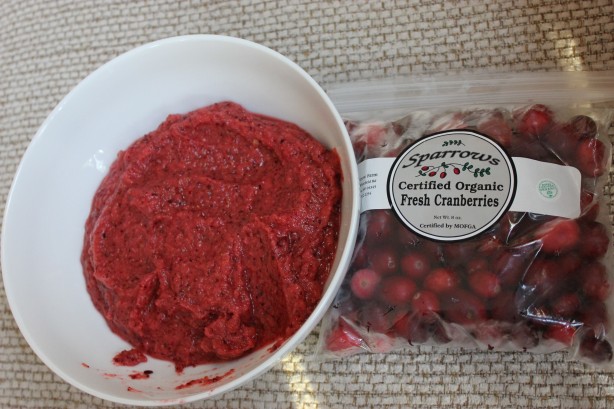
Local, organic Maine cranberries, from Sparrow Farm in Pittston. They are also veteran growers of fresh ginger, I just learned!
I have nothing against Ocean Spray. I’m even a fan of their canned, jellied sauce, mostly for its gelatinous texture and the way it lies flat on a turkey and stuffing sandwich. But if you have access to fresh berries, it’s worth making your own cranberry sauce. And you don’t even have to occupy a precious burner on your crowded Thanksgiving stove-top. My favorite cranberry sauce recipe, which I’ve made for years now, is raw, and better yet, sugar-free. This sauce is sweetened with only oranges, apples and dates and whipped up in a blender (preferably a high-powered one like a Vitamix). I often punch it up with orange zest, vanilla extract, cinnamon and nutmeg. I never knew the source of the recipe (see below), but it appears to come from Rose Lee Calabro, an old-school raw foodie. I wish I could remember which dear friend or magazine turned me on to this effortless approach.
I’m excited to receive a pound of local Maine cranberries in our Small Wonder Organics CSA box next week. They’ll be from Sparrow Farm in Pittston, which I also hear has been growing fresh ginger for years. Maybe I’ll finally try Mama Stamberg’s infamous cranberry relish this year.
Cranberry Sauce
by Rose Lee Calabro
2 C fresh cranberries
1 orange
1 apple
1 C dates
water for consistency
Process cranberries, orange, apple and dates in a blender and serve.
Susan Stamberg Ivy Manning















